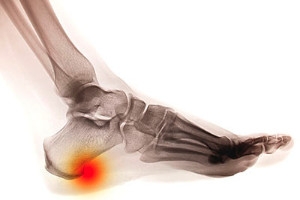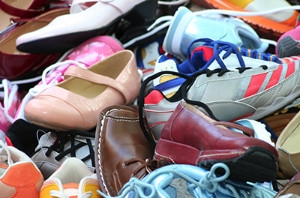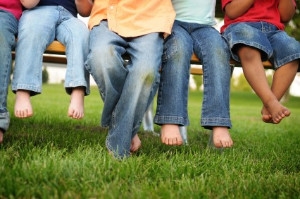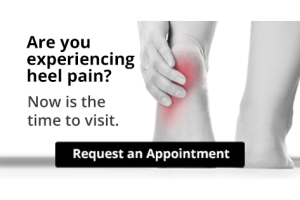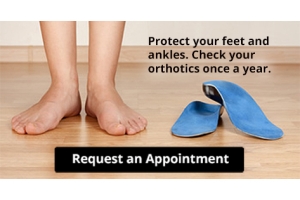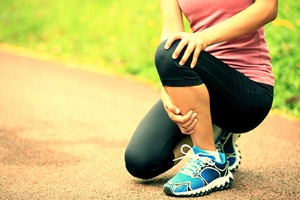
Handling Heel Spurs
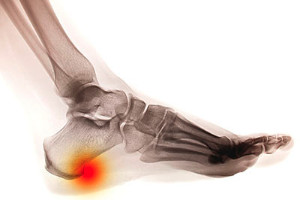 Heel spurs are potentially painful abnormalities that result from calcium deposits forming a protrusion on the underside of the heel bone. They are most common among athletes and people who do a lot of running. They are typically caused by stretching of the plantar fascia or tearing of the heel bone membrane. Depending on the severity of the heel spur, surgery may need to be performed in order to remove the calcium deposits. If you have pain in your heel, seeing a podiatrist is highly recommended. In the meantime, there are some remedies that may be able to help with the pain. These include: soaking your feet in an epsom salt bath, an apple cider vinegar bath, or applying an ice pack to the affected area.
Heel spurs are potentially painful abnormalities that result from calcium deposits forming a protrusion on the underside of the heel bone. They are most common among athletes and people who do a lot of running. They are typically caused by stretching of the plantar fascia or tearing of the heel bone membrane. Depending on the severity of the heel spur, surgery may need to be performed in order to remove the calcium deposits. If you have pain in your heel, seeing a podiatrist is highly recommended. In the meantime, there are some remedies that may be able to help with the pain. These include: soaking your feet in an epsom salt bath, an apple cider vinegar bath, or applying an ice pack to the affected area.
Heel spurs can be incredibly painful and sometimes may make you unable to participate in physical activities. To get medical care for your heel spurs, contact one of our podiatrists from PA Foot & Ankle Associates. Our doctors will do everything possible to treat your condition.
Heels Spurs
Heel spurs are formed by calcium deposits on the back of the foot where the heel is. This can also be caused by small fragments of bone breaking off one section of the foot, attaching onto the back of the foot. Heel spurs can also be bone growth on the back of the foot and may grow in the direction of the arch of the foot.
Older individuals usually suffer from heel spurs and pain sometimes intensifies with age. One of the main condition's spurs are related to is plantar fasciitis.
Pain
The pain associated with spurs is often because of weight placed on the feet. When someone is walking, their entire weight is concentrated on the feet. Bone spurs then have the tendency to affect other bones and tissues around the foot. As the pain continues, the feet will become tender and sensitive over time.
Treatments
There are many ways to treat heel spurs. If one is suffering from heel spurs in conjunction with pain, there are several methods for healing. Medication, surgery, and herbal care are some options.
If you have any questions feel free to contact one of our offices located in Allentown, Easton, Northampton, and Chew Street in Allentown, PA . We offer the latest in diagnostic and treatment technology to meet your needs.
Heel Spurs
Heel spurs are the result of calcium deposits that cause bony protrusions on the underside of the heel. Heel spurs are usually painless, but they have the potential to cause heel pain. Heel spurs tend to be associated with plantar fasciitis, which is a condition that causes inflammation of the band of connective tissue that runs along the bottom of the foot. They most often occur to athletes whose sports involve a lot of running and jumping.
Some risk factors for developing heel spurs include running and jogging on hard surfaces, being obese, wearing poorly fitting shoes, or having walking gait abnormalities.
It is possible to have a heel spur without showing signs of any symptoms. However, if inflammation develops at the point of the spur’s formation, you may have pain while walking or running. In terms of diagnosis, sometimes all a doctor needs to know is that the patient is experiencing a sharp pain localized to the heel to diagnose a heel spur. Other times, an x-ray may be needed to confirm the presence of a heel spur.
Heel spurs can be prevented by wearing well-fitting shoes that have shock-absorbent soles. You should also be sure that you are choosing the right shoe for the activity you want to partake in; for example, do not wear walking shoes when you want to go on a run. Additionally, maintaining a healthy weight can be beneficial toward preventing heel spurs, as it will prevent an excess amount of pressure being placed on the ligaments.
There are a variety of treatment options for people with heel spurs. Some of these include stretching exercises, physical therapy, shoe inserts, or taping and strapping to rest stressed muscles and tendons. If you have heel pain that lasts longer than a month, don’t hesitate to seek help from a podiatrist. Your doctor can help you determine which treatment option is best for you.
Finding the Right Shoes for Women
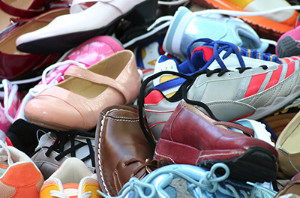 It is recommended by the Centers for Disease Control and Prevention that “at least two and a half hours per week” of walking should be the minimum amount of aerobic activity to stay healthy. However, at least 57 percent of women fail to meet this standard. In order to get the right amount of exercise, women need the right shoes. When finding properly-fitting shoes, make sure that your shoes have a wide toe box, allowing your toes to move naturally. Look for shoes that have “seamless uppers,” or “little stitching and no rough edges to rub against your feet.” Overall, good shoes should offer protection and support.
It is recommended by the Centers for Disease Control and Prevention that “at least two and a half hours per week” of walking should be the minimum amount of aerobic activity to stay healthy. However, at least 57 percent of women fail to meet this standard. In order to get the right amount of exercise, women need the right shoes. When finding properly-fitting shoes, make sure that your shoes have a wide toe box, allowing your toes to move naturally. Look for shoes that have “seamless uppers,” or “little stitching and no rough edges to rub against your feet.” Overall, good shoes should offer protection and support.
Finding a properly-fitting shoe is important in reducing injuries and preventing foot problems. For more information about treatment, contact one of our podiatrists from PA Foot & Ankle Associates. Our doctors will treat your foot and ankle needs.
Proper Shoe Fitting
A common concern when it comes to foot health, having properly fitted shoes can help prevent injuries to the foot. Out feet affect our posture and gait, which in turn affects the biomechanics and overall bodily structure. With 33 joints, 26 bones, and over 100 ligaments, the potential for serious injury is much greater than one realizes. Although the feet cease growth in adulthood, they still change shape as they mature. Here are some factors to consider when it comes to investing in proper fitting shoes:
- Be sure the shoes fit correctly right away
- Ensure the ball of your foot fits comfortably in the widest portion of the shoes
- Even though they may look fashionable, improper fitting shoes can either create adverse conditions or exacerbate existing ones you may already have
- Walk along a carpeted surface to ensure the shoes comfortably fit during normal activity
Keeping in mind how shoes fit the biomechanics of your body, properly-fitting shoes are vitally important. Fortunately, it is not difficult to acquire footwear that fits correctly. Be sure to wear shoes that support the overall structure of your body. Do your feet a favor and invest in several pairs of well-fitted shoes today.
If you have any questions please feel free to contact one of our offices located in Allentown, Easton, Northampton, and Chew Street in Allentown, PA . We offer the newest diagnostic and treatment technologies for all your foot and ankle needs.
Proper Shoe Fitting
When it comes to maintaining foot health, wearing properly-fitting shoes is important. While wearing the appropriate pair of shoes may seem like a trivial concern, the reality is that improperly fitted shoes cause an astounding amount of injuries to the feet. The overall structure and the biomechanics of our bodies are directly affected by our posture, gait, and feet. Because of this, pain and discomfort felt throughout the body are often related to a problem in the feet. And, most foot problems usually stem from improper footwear.
Shoes should not be purchased with the expectation that they will easily stretch and contort to the size and shape of your feet. When shopping for footwear, look for shoes that fit correctly and comfortably as soon as you put them on. Do not purchase shoes that are too large or that slip in the heel area when you walk. Do not choose shoes that are loose with the intention of wearing thicker socks to compensate for the space. The widest portion of the shoe, the ball of the foot, must be made sure to fit comfortably in the shoe.
Keeping all of these suggestions in mind may be difficult when shopping and when trying to select from a wide array of different shoes. Nonetheless, your time and money will be wasted if you purchase a pair of shoes that are too uncomfortable for you to actually wear them. After finally selecting and purchasing a pair of shoes, try them on at home. To truly ensure whether or not your shoes fit comfortably with normal activity, walk around on a carpeted surface to determine how they feel on your feet.
The possibility of damaging your feet’s 33 joints, 26 bones, and 100+ ligaments is much higher than many people suspect. Finding an appropriate and properly-fitted pair of shoes is perhaps the single most important action you can take to maintain excellent foot health and help prevent injury. The fact that our feet continue to change with age is one that many people often forget. Even if our feet no longer change in size when we mature, our feet will still change in shape.
If you already have pre-existing foot problems, there is a greater possibility that wearing improperly-fitted shoes will worsen those problems. The good news, however, is that appropriate footwear is not difficult to find. While shopping for shoes, remember that improper footwear can detrimentally affect the feet, the entire body and its biomechanical structure as well. The shoes you wear can greatly impact your legs, back, and entire body, as your posture and gait are related to your feet. Finding and selecting the best properly-fitted shoes is necessary in achieving optimal health.
Tips to Prevent Injury for Child Soccer Players
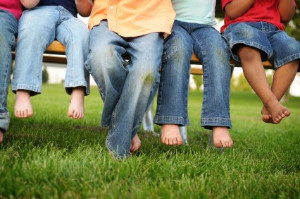 Children’s soccer has become an increasingly popular sport in the United States, making children more prone to foot and ankle injuries. The American Academy of Pediatrics states that injuries can occur when players collide and even when running, twisting or landing. Boys are more likely to incur ankle injuries especially when turning or stopping. Since children are constantly growing, some may experience irritation on the growth plate of the heel resulting in heel pain. Anti-inflammatories, ice, and stretching can help reduce this pain. However, consulting a healthcare professional is always the best bet when injuries occur. Participating in conditioning exercises, wearing proper cleats, teaching proper techniques, and maintaining field conditions can assist in preventing injury.
Children’s soccer has become an increasingly popular sport in the United States, making children more prone to foot and ankle injuries. The American Academy of Pediatrics states that injuries can occur when players collide and even when running, twisting or landing. Boys are more likely to incur ankle injuries especially when turning or stopping. Since children are constantly growing, some may experience irritation on the growth plate of the heel resulting in heel pain. Anti-inflammatories, ice, and stretching can help reduce this pain. However, consulting a healthcare professional is always the best bet when injuries occur. Participating in conditioning exercises, wearing proper cleats, teaching proper techniques, and maintaining field conditions can assist in preventing injury.
Making sure that your children maintain good foot health is very important as they grow. If you have any questions, contact one of our podiatrists of PA Foot & Ankle Associates. Our doctors can provide the care you need to keep you pain-free and on your feet.
Keeping Children's Feet Healthy
Having healthy feet during childhood can help prevent medical problems later in life, namely in the back and legs. As children grow, their feet require different types of care. Here are some things to consider...
Although babies do not walk yet, it is still very important to take care of their feet.
Avoid putting tight shoes or socks on his or her feet.
Allow the baby to stretch and kick his or her feet to feel comfortable.
As a toddler, kids are now on the move and begin to develop differently. At this age, toddlers are getting a feel for walking, so don’t be alarmed if your toddler is unsteady or ‘walks funny’.
As your child gets older, it is important to teach them how to take care of their feet.
Show them proper hygiene to prevent infections such as fungus.
Be watchful for any pain or injury.
Have all injuries checked by a doctor as soon as possible.
Comfortable, protective shoes should always be worn, especially at play.
If you have any questions please feel free to contact one of our offices located in Allentown, Easton, Northampton, and Chew Street in Allentown, PA . We offer the newest diagnostic and treatment technologies for all your foot and ankle needs.
What to Do to Keep Your Child’s Feet Healthy
Being a parent involves caring for your child in every way you can. You make sure they are eating the right food, being nice to others, and staying out of any trouble. However, it is also important that you are watchful of their health, more specifically their foot health. Maintaining good foot health in childhood is important in preventing later conditions in life from happening. As children continue to develop, their feet require different techniques of care. Here are some various ways in which you can help your child’s feet stay healthy.
A baby needs a lot of care and attention overall, but the importance of their feet should never be forgotten. Before a baby turns one, their feet change and develop greatly. It is important that during this time, a mother avoids putting tight socks on their child. She should also encourage movement of their feet so the baby can begin to feel more comfortable using them.
As a baby enters the toddler years of his or her life, they are begin to walk around. When your baby begins to take those first steps, it is crucial that they are wearing protective shoes on their feet. As a mother that is observant of your child’s feet, you may notice changes in them. This is completely normal as the feet are becoming susceptible to the activity of walking. It is normal for a toddler to be a bit unsteady or to “walk funny” at first.
When your child grows out of their toddler years, it is important that you begin to show him or her how to care for their feet on their own. Practice with your child proper hygiene in order to prevent foot fungus or infection. Since children are constantly on the move, it is crucial to be cautious of any accidents or injuries that might occur. If an injury occurs, it is advised that you take your child to be examined by a doctor immediately. Since your child is still growing, particular injuries can shift the way in which a bone or other important part of the foot is developing.
Babies and kids are always changing and growing. Your job as a parent is to make sure they stay healthy and making sure they are properly maintained. This involves proper foot care and making sure the feet stay healthy. Following this guide, your child can live a long and happy life.
Preventing Running Injuries Can Be Easy
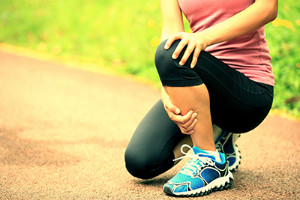 While running has many positive health benefits associated with it, it's not uncommon for runners to get hurt from the activity. Thankfully, there are several easy actions one can take to prevent potential injury. While it’s important to stretch before you run, not many people realize that stretching after a run is important as well. This prevents the muscles from shortening and tightening up. Running on natural surfaces can also be easier on the joints. Alternatively, starting on a treadmill or sidewalk isn’t bad. Take it slow the first time you run; pushing yourself too hard can lead to injury. Finally, a good pair of shoes that aren’t too cushioned and that are well-fitted can also help prevent foot pain. Running injuries always have the potential to occur, but following these steps can help significantly in preventing them. Just remember to consult with a podiatrist first about running and whether it is appropriate for you.
While running has many positive health benefits associated with it, it's not uncommon for runners to get hurt from the activity. Thankfully, there are several easy actions one can take to prevent potential injury. While it’s important to stretch before you run, not many people realize that stretching after a run is important as well. This prevents the muscles from shortening and tightening up. Running on natural surfaces can also be easier on the joints. Alternatively, starting on a treadmill or sidewalk isn’t bad. Take it slow the first time you run; pushing yourself too hard can lead to injury. Finally, a good pair of shoes that aren’t too cushioned and that are well-fitted can also help prevent foot pain. Running injuries always have the potential to occur, but following these steps can help significantly in preventing them. Just remember to consult with a podiatrist first about running and whether it is appropriate for you.
Exercising your feet regularly with the proper foot wear is a great way to prevent injuries. If you have any concerns about your feet, contact one of our podiatrists of PA Foot & Ankle Associates. Our doctors will treat your foot and ankle needs.
How to Prevent Running Injuries
Many common running injuries are caused by overuse and overtraining. When the back of the kneecap starts wearing out and starts causing pain in your knee, this is commonly referred to as runner’s knee. Runner’s knee is a decrease in strength in your quadriceps and can occur if you’re not wearing properly fitted or supporting shoes. To prevent runner’s knee, focusing on hip strengthening is a good idea, as well as strengthening your quads to keep the kneecaps aligned.
What Are Some Causes of Running Injuries?
- One cause of a common running injury is called iliotibial band syndrome.
- Plantar fasciitis is also another common injury.
- Stress fractures can occur from overtraining, lack of calcium, or even your running style.
Best Ways to Prevent Running Injuries
- Wear footwear that fits properly and suits your running needs.
- Running shoes are the only protective gear that runners have to safeguard them from injury.
- Make a training schedule. Adding strengthening exercises as well as regular stretching can help keep you strong and limber and can lessen the possibility of injuries.
- Stretching keeps muscles limber; this will help you gain better flexibility.
If you have any questions please feel free to contact one of our offices located in Allentown, Easton, Northampton, and Chew Street in Allentown, PA . We offer the newest diagnostic and treatment technologies for all your foot and ankle needs.


